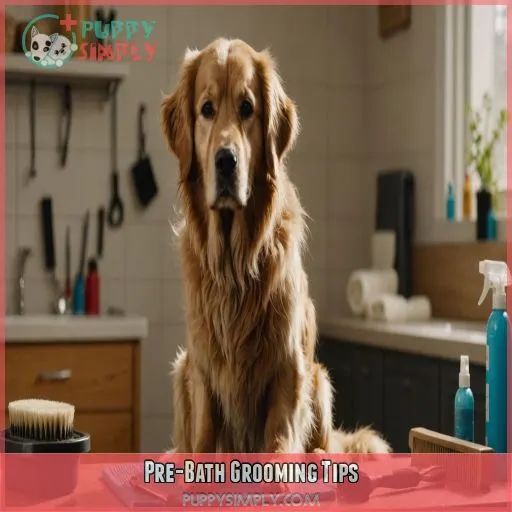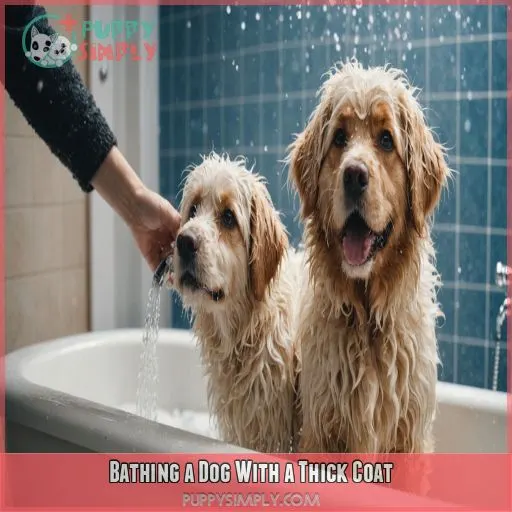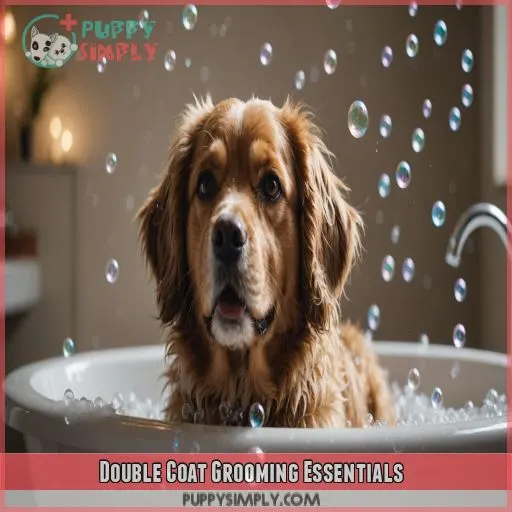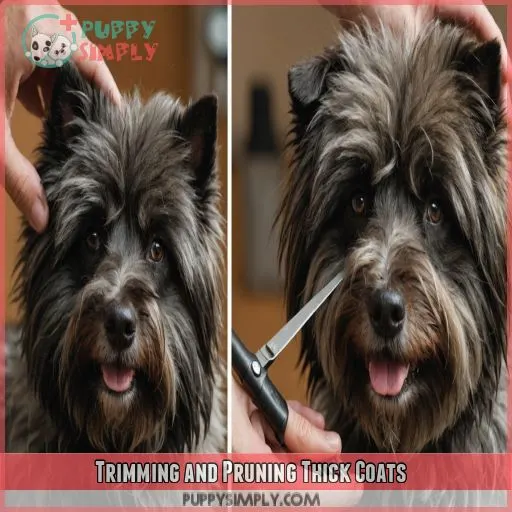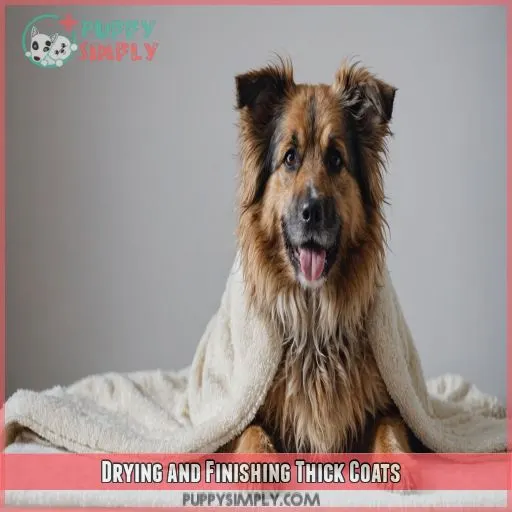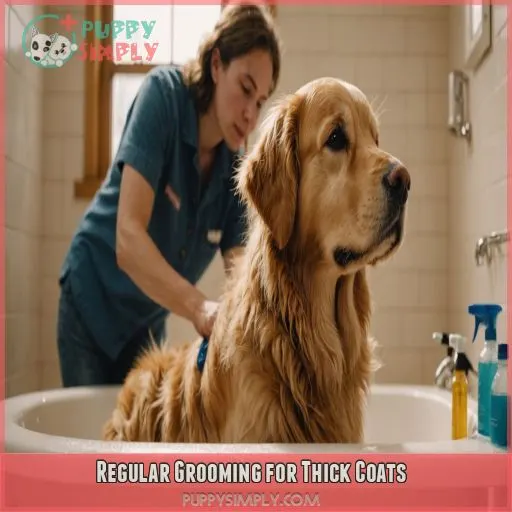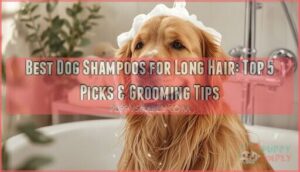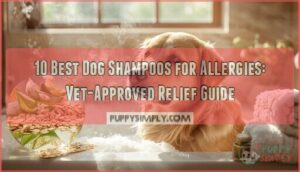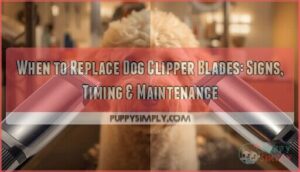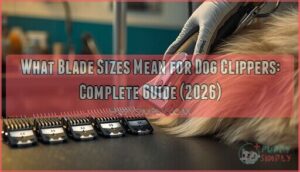This site is supported by our readers. We may earn a commission, at no cost to you, if you purchase through links.
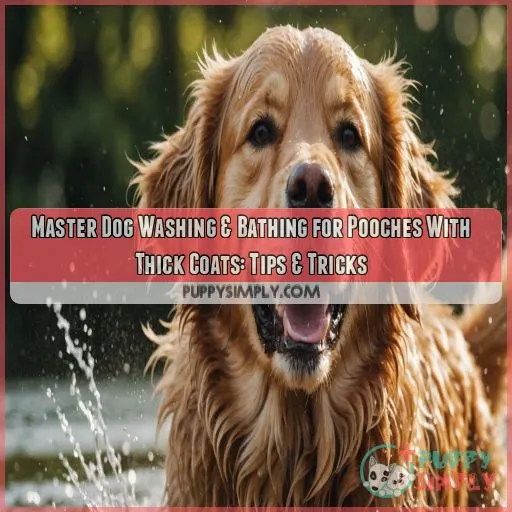
But don’t worry, with the right techniques, you’ll be a pro in no time.
Before the bath, brush their coat thoroughly to prevent matting and tangling.
When bathing, use a shampoo specifically designed for thick coats and work it into their undercoat.
Be gentle and patient, as thick coats can be prone to matting.
Rinse thoroughly and condition to keep their coat healthy and shiny.
Want to learn more about mastering the art of dog washing and bathing for dogs with thick coats?
Table Of Contents
- Key Takeaways
- Pre-Bath Grooming Tips
- Bathing a Dog With a Thick Coat
- Double Coat Grooming Essentials
- Trimming and Pruning Thick Coats
- Drying and Finishing Thick Coats
- Regular Grooming for Thick Coats
- Frequently Asked Questions (FAQs)
- How to bathe a dog with a thick coat?
- How to shampoo a double coated dog?
- How to groom a dog with thick fur?
- How often should double coated dogs be bathed?
- How often should I bathe my thick-coated dog outside?
- Can I use human shampoo on my dogs thick coat?
- What are the best tools for detangling thick dog coats?
- How do I prevent matting in my dogs thick coat?
- Can I use a hair dryer on my dogs thick coat?
- Conclusion
Key Takeaways
- Before bathing your furry friend, brush their thick coat thoroughly to prevent matting and tangling—it’s a total game-changer for both you and your dog! Use a brush designed for double coats, and focus on areas like the undercoat and behind the ears, which are prone to tangles.
- When bathing your dog with a thick coat, use a shampoo specifically designed for their coat type, and work it into their undercoat to keep their coat healthy and shiny. Be gentle and patient, as thick coats can be prone to matting, and rinse thoroughly to remove all soap residue.
- To prevent matting and tangling, brush your dog regularly, especially after bathing, using a brush specifically designed for thick coats. You can also use a detangling tool or a leave-in conditioner to make combing and brushing easier.
- When drying your dog’s thick coat, gently pat them dry with a towel, then let them air dry or use a blow dryer on a low setting. Be cautious not to overheat or scare them, and use a cool setting to set their coat; then, brush against the grain for a sleek finish.
Pre-Bath Grooming Tips
You’re about to give your furry friend a bath, but before you get them wet, you should give them a good brushing to prevent matting and tangling, especially if they’ve a thick coat. Pre-bath grooming is a game-changer for both you and your dog, making the bathing process smoother, reducing shedding, and preventing damage to their coat.
Benefits of Pre-Bath Grooming
Pre-bath grooming makes a huge difference! It leads to less damage, smoother brushing, and prevents matting. Plus, it makes detangling a breeze, saving you and your dog a ton of stress.
Pre-Bath Grooming for Dogs With Thick Coats
Pre-bath brushing is a must for dogs with thick coats. It helps remove dead hair and prevents matting. Focus on areas like the undercoat and behind the ears, which are prone to tangles. Use a brush designed for double coats.
How to Brush a Dog Before a Bath
Before bathing, grab your brushing tools and gently work out tangles in the direction of coat growth. This helps prevent matting, reduces shedding, and makes the bathing process a whole lot smoother.
Tips for Minimizing Shedding and Matting
To minimize shedding and matting, brush your dog regularly, especially before baths. Here are three tips to get you started:
- Brush with the right tools: Use a slicker brush or pin brush for short-haired dogs and a rake or mat breaker for long-haired breeds.
- Brush with frequency: Brush your dog 2-3 times a week, or daily for dogs with thick coats or matting issues.
- Be gentle and patient: Brushing can be relaxing for dogs, so take your time and be gentle, especially around sensitive areas.
Bathing a Dog With a Thick Coat
Bathing your dog with a thick coat can be a bit of a challenge, but with the right techniques and products, you can keep their coat clean and healthy. Whether your dog has a double coat or just a thick, single layer, learning how to bathe them properly will make a huge difference in their comfort and appearance.
Choosing the Right Shampoo for Thick Coats
When choosing a shampoo for your thick-coated dog, consider their coat type, shedding, and skin health. Look for ingredients that moisturize and nourish, while also fitting your budget. A good dog shampoo and conditioner can make all the difference in their coat’s health and appearance.
How to Bathe a Dog With a Double Coat
Bathing a dog with a double coat requires special care. Use a dog-specific shampoo and conditioner designed for double coats, and bathe every 1 to 12 weeks, depending on their tolerance, skin condition, and the season. Thoroughly rinse to remove all soap residue.
How to Avoid Matting and Tangling
To avoid matting and tangling, brush your dog thoroughly before bathing, using a detangler product if needed. For silky coats, use a pin brush or slicker brush, while wiry coats benefit from a rubber brush or bristle brush. Regular brushing prevents knots.
Double Coat Grooming Essentials
You’re probably no stranger to the extra grooming needs of your thick-coated pup, but if they’ve a double coat, there are some special considerations to keep in mind. Double coats require regular grooming to prevent matting and tangling, and the right techniques can make all the difference in keeping your dog’s coat healthy and looking its best.
What is a Double Coat?
A double coat serves as a protective shield and temperature regulator, shedding seasonally to adapt to changing weather conditions, requiring regular brushing and care to prevent matting and tangling, and promote healthy growth.
Breeds With Double Coats
You’ve got a double-coated dog! Breeds like Akitas, Chow Chows, and Siberian Huskies have two layers of fur. Regular grooming is key to prevent matting and shedding, so get ready to brush!
How to Identify a Double Coat
To identify a double coat, look for two distinct layers: a longer, coarser outer layer and a shorter, softer undercoat. Check for thickness, texture, and shedding patterns, especially around the neck and shoulders.
- Two distinct layers: A double coat has a clear distinction between the outer layer and undercoat, with the outer layer being longer and coarser.
- Thick undercoat: Double coats have a thick, soft undercoat that provides insulation and warmth, often shedding heavily during seasonal changes.
- Varied shedding patterns: Double coats exhibit different shedding patterns, such as heavy shedding during spring and fall, or consistent shedding throughout the year, depending on the breed and climate.
Grooming Tools for Double Coats
For your double-coated dog, you’ll need the right tools: a double coat brush, shedding tool, de-matting comb, undercoat rake, and grooming gloves to make bath time a breeze and prevent matting.
Trimming and Pruning Thick Coats
You’re probably wondering when and how to trim your dog’s thick coat, especially if they’ve a double coat that sheds heavily. Trimming and pruning can be a bit tricky, but with the right guidance, you can keep your dog’s coat looking healthy and prevent matting and tangling.
When to Trim a Double Coat
Trim your double-coated dog only when necessary, like when they’ve matted fur. Consult a vet or professional groomer for advice on trimming specific areas for hygiene and comfort.
How to Trim a Double Coat
When trimming a double coat, focus on specific areas like paws, eyes, and rectum for hygiene and comfort. Use double coat trimming tools and consider DIY vs. professional grooming for best results.
Tips for Pruning Thick Coats
When pruning thick coats, focus on specific areas like paws, hocks, and eyes to prevent matting and promote hygiene. Use the right tools and techniques to avoid damaging the coat.
Avoiding Common Trimming Mistakes
When trimming your dog’s thick coat, avoid common mistakes by following these tips:
- Don’t cut too close to the skin, as this can cause irritation and ingrown hairs.
- Use the right clippers for your dog’s coat type to prevent matting and uneven cuts.
- Work slowly and carefully to avoid accidents and make sure you and your dog have a relaxing experience.
Drying and Finishing Thick Coats
You’ve made it through the bathing process, and now it’s time to dry and finish your dog’s thick coat – a really important step to prevent matting and tangling. In this section, we’ll share practical tips on how to dry a thick coat, including blow-drying techniques and finishing touches to keep your dog’s coat healthy and looking its best.
How to Dry a Thick Coat
Now that you’ve trimmed and pruned your dog’s thick coat, it’s time to dry them off. Gently pat them dry with a towel, then let them air dry or use a blow dryer on a low setting.
Tips for Blow-Drying a Double Coat
When blow-drying your double-coated dog, use a low heat setting and brush their coat carefully against the grain to straighten curls and reach all layers of fur, ensuring a fluffy finish.
How to Prevent Matting and Tangling
As you dry your dog, prevent matting and tangling by gently working out knots with a detangling tool or slicker brush. Here are four tips to help:
- Use the right brush: Choose a brush type that’s designed for your dog’s coat, such as a slicker brush or pin brush.
- Work in sections: Divide your dog’s coat into sections, and gently work out tangles one section at a time.
- Be gentle: Don’t yank or pull on tangles, as this can cause breakage and pain. Instead, gently tease out knots with your brush or detangling tool.
- Use a leave-in conditioner: A leave-in conditioner can help make combing and brushing easier, while also preventing matting and tangling.
Finishing Touches for a Healthy Coat
You’re almost done! Finishing touches for a healthy coat involve blow-drying, brushing, and a final inspection. Use a cool setting to set the coat, then brush against the grain for a sleek finish.
Regular Grooming for Thick Coats
You’re probably no stranger to the struggles of dealing with your dog’s thick coat, from matting and tangling to shedding all over the house. Regular grooming is key to keeping your furry friend’s coat healthy and looking its best, and with a few simple tips and tricks, you can make the process a whole lot easier on both of you.
Regular Brushing for Thick Coats
Now that you’ve mastered drying and finishing thick coats, it’s time to talk regular brushing. For dogs with thick coats, daily brushing is a must to prevent matting and tangling. Use a slicker brush or pin brush, and brush with the grain to keep their coat healthy.
Tips for Maintaining a Healthy Coat
To maintain a healthy coat, brush your dog regularly, focusing on areas prone to matting. Use the right grooming tools, and bathe them as needed. Nutrition also plays a role, so make sure their diet supports coat health and shedding control.
Signs of a Healthy Coat
You know your dog’s coat is healthy when it’s shiny, soft, and smooth to the touch. Regular grooming helps maintain a vibrant, thick coat. Look for a coat that lies flat, with no matting or tangling, and a healthy sheen that catches the light.
Frequently Asked Questions (FAQs)
How to bathe a dog with a thick coat?
First, brush their thick coat to remove tangles and mats. Wet their fur thoroughly, then shampoo, working from back to front. Rinse well. Towel dry, then blow-dry, brushing against the grain to straighten and reach all fur layers.
How to shampoo a double coated dog?
Bathing a double-coated dog? You’re in for a treat! Start by using a dog-specific shampoo and conditioner, working from back to front, and be sure to rinse thoroughly to avoid any pesky soap residue.
How to groom a dog with thick fur?
Grooming a dog with thick fur requires patience and the right tools. Start by brushing their coat to prevent matting, then use clippers or scissors specifically designed for thick fur, taking care not to cut too close to the skin.
How often should double coated dogs be bathed?
You should bathe your double-coated dog every 1 to 12 weeks, depending on their tolerance, skin condition, and the season. Increased shedding during certain seasons may require more frequent bathing to keep them clean and comfortable.
How often should I bathe my thick-coated dog outside?
When bathing your thick-coated dog outside, consider the weather and their individual needs. Aim for every 1-12 weeks, or as needed. Be mindful of temperature extremes and make sure to give them a thorough rinse to prevent skin irritation.
Can I use human shampoo on my dogs thick coat?
Don’t go barking up the wrong tree by using human shampoo on your dog’s thick coat! It can strip their natural oils, leading to dryness and irritation. Instead, opt for a dog-specific shampoo designed for their unique needs.
What are the best tools for detangling thick dog coats?
You’ll need the right tools to tackle that tangled mess! Grab a slicker brush, pin brush, or a detangling rake specifically designed for thick coats. These will help you gently work out knots without causing breakage or pain.
How do I prevent matting in my dogs thick coat?
An ounce of prevention is worth a pound of cure" when it comes to matting in your dog’s thick coat. Regular brushing, especially after bathing, helps prevent matting. Use a brush specifically designed for thick coats and brush with the grain.
Can I use a hair dryer on my dogs thick coat?
You can use a hair dryer on your dog’s thick coat, but be cautious not to overheat or scare them. Use a low setting and keep the dryer moving to prevent hot spots and promote even drying.
Conclusion
You’re now a pro at dog washing and bathing for dogs with thick coats!
Who knew mastering the art of bathing your furry friend could be so rewarding?
With these tips and tricks, you’ll be able to tackle even the thickest of coats with confidence.
Keep your furry friend’s coat healthy and shiny, and they’ll thank you for it!

